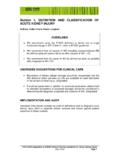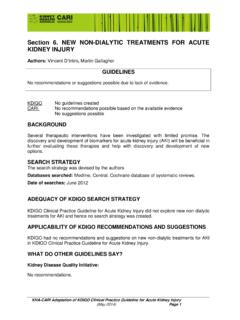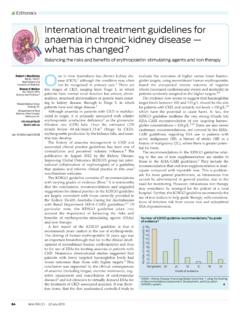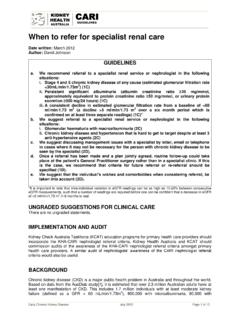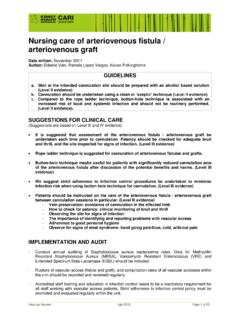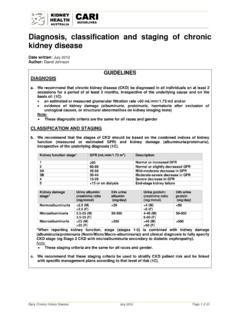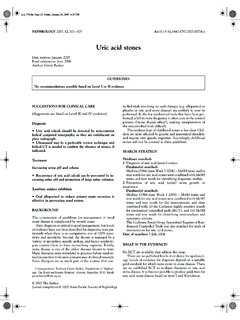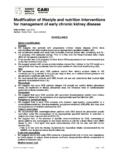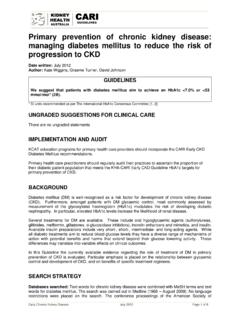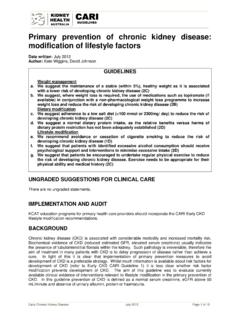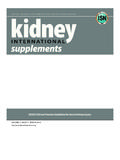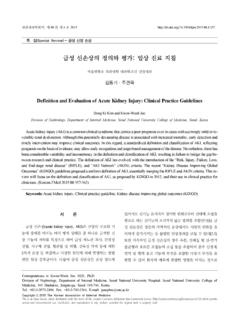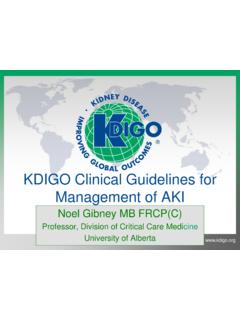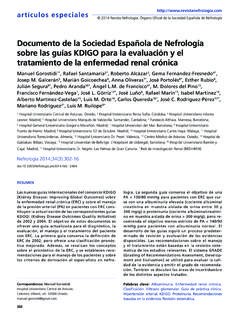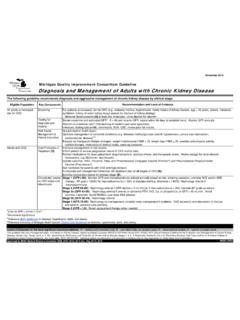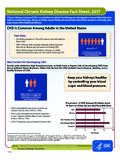Transcription of Original Article Commentary on the KDIGO Clinical …
1 Original ArticleCommentary on the KDIGO Clinical Practice Guideline for themanagement of blood pressure in chronic kidney diseaseMATTHEW A ROBERTSD epartment of Renal Medicine, Eastern Health Clinical School, Monash University, Melbourne, Victoria, AustraliaCorrespondence:Dr Matthew Roberts, Dept of Nephrology, BoxHill Hospital, Eastern Health, Level 2, 5 ArnoldSt, Box Hill, Vic. 3128, Australia. for publication 7 October manuscript online 15 October blood pressure is an important modifiable riskfactor for both cardiovascular disease (CVD) and progressionto end-stage kidney disease (ESKD).1 Much time and effort inchronic kidney disease (CKD) clinics is spent on measuringblood pressure, deciding whether to escalate treatment, andwhich agent to use.
2 Blood pressure is therefore an essentialtopic for the Kidney Disease Improving Global Outcomes( KDIGO ) group2to tackle. Their Clinical Practice Guidelinefor the Management of Blood Pressure in Chronic KidneyDisease, published inKidney Internationalin December 2012,3makes 21 recommendation statements based on the avail-able evidence presented by the Tufts Medical Centre-basedEvidence Review Team (summarized in 62 supplementaltables).The KDIGO Blood Pressure Guideline illustrates some ofthe challenges of writing evidence-based guidelines , whichare: (i) distilling a complicated Clinical issue into a practicalguideline statement that can be implemented; (ii) adjudicat-ing the quality of evidence for each statement; and (iii)remaining consistent within the guideline and with guide-lines for other SUMMARYThis KDIGO Guideline deals with patients with CKD who donot require dialysis and includes chapters on kidney trans-plant recipients, children and the elderly.
3 Nine of the 21recommendation statements are contained in two separatechapters regarding CKD patients according to diabetes pressure in patients receiving dialysis was discussed ata KDIGO Controversies Conference that resulted in norecommendation statements but many recommendationsfor key recommendations for non-dialysisCKD are: Treat adult patients without albuminuria to keep officeblood pressure consistently 140/90 mmHg (with andwithout diabetes); Treat adult patients with any level of albuminuria tokeep office blood pressure consistently 130/80 mmHg, andinclude an angiotensin-converting enzyme inhibitor (ACEi)or angiotensin receptor blocker (ARB) in the treatmentregimen (with and without diabetes); Treat adult kidney transplant recipients to keep officeblood pressure consistently 130/80 mmHg.
4 Treat children with an ACEi or ARB if blood pressure isconsistently>90th percentile, aiming for systolic and dias-tolic readings 50th percentile for age, sex and KDIGO Guideline provides a more rigorous analysis ofthe evidence for a lower target blood pressure ( 130/80vs140/90 mmHg) in patients without proteinuria than mostother guidelines (Table 1).5 11 The Evidence Review Teamperformed a systematic review of blood pressure targets andfound eight reports of three trials that randomized 2272patients with CKD to different blood pressure targets butcould not generate summary estimates as proteinuria andoutcome definitions were too dissimilar between the diverging from most other guidelines , the KDIGO WorkGroup considered the nature of the endpoints (predomi-nantly renal)
5 , that subgroup analyses of two of the trialsdemonstrated no benefit in the groups without proteinuria,possible adverse effects of antihypertensive therapy andreduced patient adherence to therapy when more agents arerequired to reach a lower target. For patients with proteinu-ria, the KDIGO Work Group recommended the lower targetbs_bs_bannerNephrology19(2014) 53 55 2013 Asian Pacific Society of Nephrology53of 130/80 mmHg, albeit with lower levels of evidence giventhat this was based on post-hoc analyses of subgroups withproteinuria in two of the trials13,14included in the evidence regarding treatment of blood pressure inCKD, as evaluated by the KDIGO Work Group, appears to belacking (Fig.)
6 1). No 1A recommendation is made in thisguideline and the predominant grading for the statements is 2D . Given that evidence for 2D statements is considered tobe very low in quality and the estimate of effect often willbe far from the truth ,3this should be of concern to physi-cians managing patients with CKD and stimulate interest inconducting randomized controlled trials (RCT) to furtherclarify what blood pressure to target in which we clearly do not have enough RCT data to under-pin this guideline, has this guideline group been particularlysevere in its grading of the evidence? The evidence behindthe statements for patients with microalbuminuria or overtproteinuria is graded 2D and 2C using the Grading of Rec-ommendations Assessment, Development and Evaluation(GRADE) tool but the recent KHA-CARI guideline on EarlyChronic Kidney Disease grades the evidence for a similarstatement as 1B6(Table 1).
7 Furthermore, an RCT is consid-ered to be a High level of evidence in the GRADE systembut the guideline statements regarding blood pressure targetsand agents in the chapter on children are graded 2D. Theguideline statements are based on a single RCT, the Effect ofStrict Blood Pressure Control and ACE Inhibition of Progres-sion of CRF in Paediatric Patients (ESCAPE) trialdemonstrated that intensified blood pressure control in chil-dren, targeting a mean arterial pressure below the 50th per-centile, delayed progression to doubling of serum creatinineor ESKD, with a hazard ratio of (95% confidence inter-val ,P= ) compared with usual blood pressurecontrol.
8 Although this was a large, well-designed RCTwithout serious limitations and rated by the EvidenceReview Team to be of Good quality for this outcome, theWork Group downgraded the evidence because it was basedon a single trial in a predominantly Caucasian population. Incontrast, the first statement regarding kidney transplantrecipients recommends a blood pressure target of 130/80 mmHg and grades the evidence 2D, the same as for bloodpressure in children. However, this 2D is based on observa-tional data only as there has not been an RCT in kidneytransplant recipients comparing blood pressure targets. Therigour applied to interpreting the data for the adult CKDblood pressure targets (Chapters 3 and 4) has not beenapplied to kidney transplant recipients (Chapter 5).
9 The mostlikely reason is what is stated in the text: that a blood pres-sure target has already been stated in another KDIGO KDIGO Management of Blood Pressure in CKDWork Group state that there is no new data to contradict theprevious statement, although they reduced the grade fromTable 1 The KDIGO Blood Pressure in chronic kidney disease (CKD) Guideline, current Australian and New Zealand guidelines (ANZ) and other international (INT)guideline statements regarding goal blood pressure in CKD No diabetesDiabetesACR:NormalMicroMacroNorm alMicroMacroKDIGO 20123140/90 (1B)130/80 (2D)130/80 (2C)140/90 (1B)130/80 (2D)130/80 (2D)ANZKHA-CARI6140/90 (1B)130/80 (1B)130/80 (1B)130/80 (1B)130/80 (1B)130/80 (1B)NHF Aus 20088130/80130/80125/75 130/80130/80125/75NZ guidelines Group 201210130/80130/80130/80130/80130/80130/ 80 NVDPA 20129140/90130/80130/80130/80130/80130/8 0 InternationalJNC VII 20035130/80130/80130/80130/80130/80130/8 0 NICE CG7311140/90140/90130/80 130/80130/80130/80UK Renal Association 20117140/90 (2C)140/90 (2C)130/80 (2C)130/80 (2C)130/80 (2C)130/80 (2C) Grade for evidence in parentheses where stated are according to the GRADE system.
10 Recommendation if proteinuria>1 g/day (not 300 mg/day). ACR, albuminto creatinine ratio; GRADE, Grading of Recommendations Assessment, Development and Evaluation; KDIGO , Kidney Disease Improving Global 1 Number of KDIGO guideline recommendations3by grade of evidence . KDIGO , Kidney Disease: Improving Global Outcomes. Using the Gradingof Recommendations Assessment, Development and Evaluation (GRADE) Roberts 2013 Asian Pacific Society of Nephrology542C to 2D. Consistency is not just a problem for KDIGO , asmanagement of blood pressure permeates many areas ofnephrology and therefore, many guidelines . For example,the KHA-CARI Guideline for the Detection, Prevention andManagement of Early Chronic Kidney Disease, which rec-ommends blood pressure targets6(Table 1) was preceded byfive different guidelines that are now out of date and threeguidelines that remain current, all of which make statementsabout issues covered in the KDIGO BP Guideline (see accessed15/7/2013).
